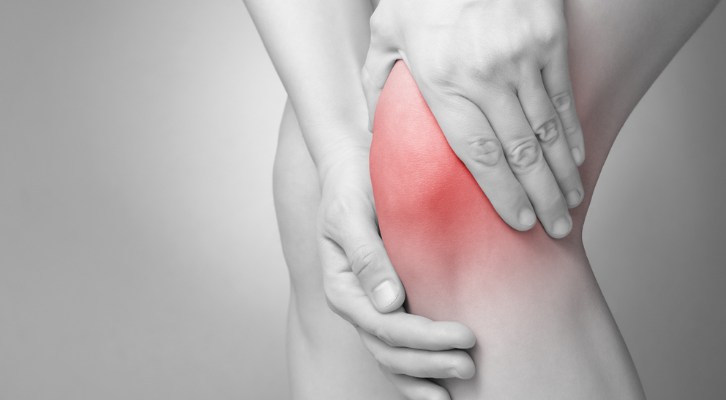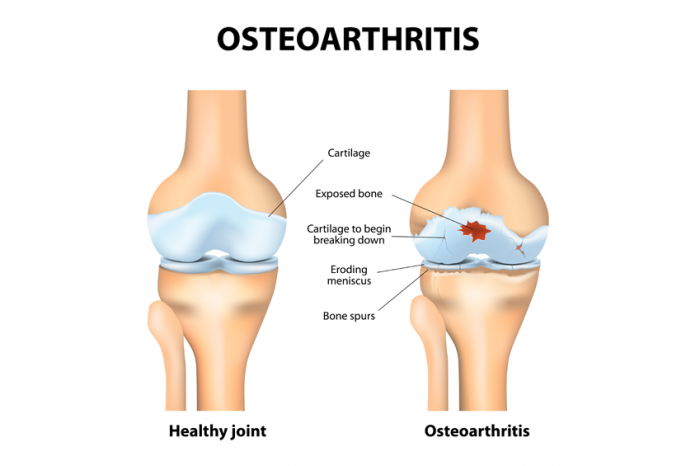Arthritis afflicts 54 million U.S. adults, according to the Arthritis Foundation
Several years ago, I was walking down 58th Street in New York City. It was a beautiful summer day and I was wearing a brand new pair of white and silver sandals. As I walked across a grating that was wet from dripping condensation from an air conditioner, I lost my footing and fell down hard on both knees. My left knee smashed into the grating and I felt excruciating pain. But that was my least concern, or so I thought at the time. As I fell, my skirt flew over my head exposing my Spanx-clad rear to anyone walking or driving nearby. A couple walking by helped me to my feet and, when they saw my badly bruised knee, offered to take me to a local hospital. I declined and hobbled home, embarrassed at my gracelessness and the fact that I’d mooned the east side of Manhattan.

My knee was badly injured. It became severely swollen and was an array of unattractive and angry colors. I couldn’t bend it and, even the act of doing nothing, hurt. But no, I didn’t go to a doctor. (This will not be at all surprising to family and friends who know me. You know how some people are terrified of dentists and visit them less frequently than they should? Well, that’s me and doctors.) Neither the pain, the loss of function, nor the swelling and discoloration motivated me to see a doctor. As I recall, the pain and swelling lasted a good six weeks.
I never really thought about that fall after that, until my knees began to hurt. I used to spend a lot of time at the gym. I loved working my legs, well, I loved working my quadriceps (front thigh) muscles. I was proud of the fact that I could leg press an amount close to my weight. I could easily lift 40 lbs. doing leg extensions and I could squash the 30 Day Squat Challenge in 15 days. My legs were strong, but my knees hurt. When the pain became intense enough to send me to an orthopedist, I was told I had bone-on-bone arthritis and would need surgery to scrape out the rough parts caused by the arthritis, which would help ease the pain. My aversion to most things medical sent me running out the door as I tried to deal with the knee pain on my own. (In other words, I did my best to ignore the entire issue and carry on the best that I could.) I continued to blast my legs on exercise machines, to walk 6 miles on most days, and to ignore the pain. Several falls later, most recently one that changed the profile of the pain in my right knee – it hurt differently and so severely that I cannot walk up and down stairs – I decided it was time to seek medical help once again.

A recent MRI revealed, in addition to severe arthritis, a meniscus tear in the right knee. That explained the change in the type of pain I am experiencing. Now, I await a new orthopedist’s recommendation. My second appointment is next week and, in the meantime, I took to the internet to learn what I could about arthroscopic surgery, which I was told might be in my future during my first visit with the new doctor. Of course, I’m wary and my internet search for alternative methods to reduce arthritis pain revealed that arthroscopic surgery may not be the answer and may, in fact, worsen pain over time, according to the Arthritis Foundation which bases this on various studies. Here’s a quickie recap of the most recent research findings.
So, instead of surgery, what can one do to reduce arthritis pain, which can be so debilitating it limits activity level and the quality of one’s life? Here are 5 Non-Surgical Ways to deal with Arthritis, according to orthopedist and author Dr. Victor Romano … (Of course, always speak with your own doctor about treatment options that are best for you.)
Arthritis is the leading cause of disability among U.S. adults over 55, and in many cases leads to total-joint replacements. That is a big decision – sometimes necessary, sometimes premature, says Dr. Victor Romano, an orthopedist and author of Finding The Source: Maximizing Your Results – With and Without Orthopaedic Surgery.
“Total-joint replacements are wonderful and can be life-changing, but they also can wear down and become infected,” Romano says.
“The best approach for arthritis of the knee, for example, is to wait as long as possible before replacing the knee. There are several steps you can take to deal with arthritis before a surgical option. These measures, some of which you can perform without the aid of a medical professional, often can significantly lessen the pain and improve the quality of life.”
• Wear good shoes with arch supports. With weight bearing and time, the arches in feet tend to fail. “Good shoes with arch supports improve the alignment of the feet and ultimately improve the alignment of the knees,” Romano says. “The feet and ankles act as shock absorbers for the knees.”
• Have a daily exercise and balance program. Studies show that arthritic patients who exercise do much better than those who don’t. Romano recommends at least a 20-minute daily exercise program for all patients with arthritis. “Exercise should include stretching, aerobic activity, and strength training,” he says.
• Use a hinged knee brace, as needed, for support. Wear the smallest brace that makes you the most comfortable. “Do not wear the brace for everyday activities,” Romano says, “but for extra activities such as golfing, shopping or exercise. It unloads the arthritic area and allows you to pursue more pain-free activities, which you may not have been able to do otherwise.”

• Eat nutritious foods; keep your weight under control. Weight loss reduces the stress on your knees and increases mobility. “Why not try an anti-inflammatory diet?” Romano says. “Sugar and processed foods cause inflammation of the arteries as well as inflammation of the joints.” (Here’s a guide of what and what not to eat to fight inflammation, from WebMD. – ML)
• Improve your bone health. Improving your bone health with increased calcium intake, daily vitamin D, and weight-bearing exercises can lessen the pain of arthritis. “Should you eventually need a total joint replacement, building up your bone density will improve your chances of having a long-lasting replacement,” Romano says.
“Arthritis is not something that can be removed with surgery or scraped out with a scope, ”Romano says. “You must listen to your joints. When you’ve tried all of these non-surgical measures and they don’t seem to work any longer, then surgery may be your best option. If surgery is necessary, rapid and successful recovery is possible by having optimized your physical and nutritional health beforehand.”
About Dr. Victor Romano
Dr. Victor Romano (http://www.drvictorromano.com) is an orthopedic surgeon in Oak Park, Ill., and the author of Finding The Source: Maximizing Your Results – With and Without Orthopaedic Surgery. He is board-certified in orthopedics and sports medicine with more than 25 years of experience in the field. He graduated cum laude from the University of Notre Dame and completed medical school at the University of Loyola-Chicago.
Get Dr. Romano’s book here …
YOU MAY ALSO LIKE:
The End of Back Pain by Patrick A. Roth, M.D. – A Must Read for Those with Bad Backs
What You Need to Know About Lyme Disease